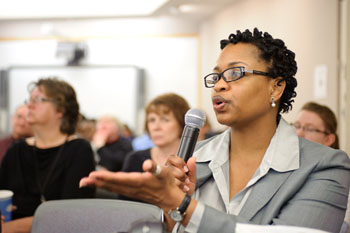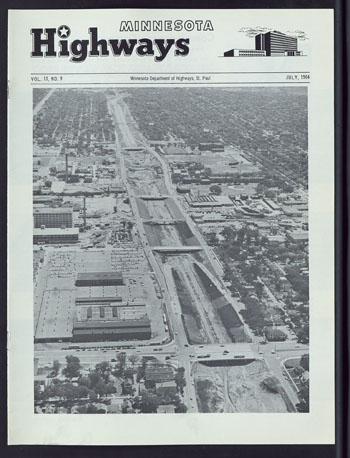By Vanessa Levingston, Office of Customer Relations

Vanessa Levingston, MnDOT Customer Relations, leads a panel discussion about past, present and future transportation impacts to African-American communities in Minnesota. Photo by David Gonzalez
|
My family moved from Chicago to the Rondo Neighborhood in St. Paul in 1976—about 10 years after Interstate 94 was built. I was seven years old and had no concept of the freeway’s impact on my new community.
The new I-94 greatly improved mobility, but it also split the primarily African-American Rondo Neighborhood in two and caused several families and businesses to move away or close. For some, the move was for the better. For others it was for the worse. When the freeway came through, several ‘mom and pop’ shops closed and were never replaced. I-94 is like a valley through the old Rondo neighborhood. Several homes still face the freeway, with no noise wall in sight.
Now, I work for the agency that arguably separated my community. I am more effective at connecting the public—particularly underserved populations—and MnDOT, because I have those memories of growing up in a community that completely changed because of a freeway.
I first realized I-94’s impact in junior high. Some community members organized a parade to celebrate and remember the Rondo Community before I-94. The idea was to bring back, for at least a day or a weekend, those who left . I was in the marching band and remember feeling silly marching down Old Rondo—commonly known as Concordia Avenue—because hardly anyone was there. The event grew and as an adult I became a board member of the Rondo Days festival, which is about music, laughter and sharing the history of Old Rondo Community.
I also remember walking across the pedestrian bridges over the interstate and feeling unsafe because they looked corroded and weak. But I frequently used them because I’ve lived on both sides and I had friends and family on both sides.
In high school, my friends and classmates labeled the once unified Rondo Neighborhood as the Selby side and the University side of the interstate. Friend groups naturally split and living on one side or the other came with its own stereotypes and assumptions. Now, kids continue the separation with identifying whether they take the route 16 or route 21 bus.

The cover of the July 1964 issue of Minnesota Highways depicts grading and paving operations on Interstate 94’s ‘depressed route’ through St. Paul. From front to rear, the picture shows the Snelling Avenue bridge to the Western Avenue grade separation. The frontage road to the left of I-94 is St. Anthony Ave. and to the right is Rondo St. This segment of I-94 was scheduled to open in fall 1964. Photo courtesy of Minnesota Highways
|
I still live in the Rondo Community, because I want to walk out the door and see faces like mine. I want my kids to have that experience too. But the neighborhood currently lacks the community and economic drive it needs to thrive. Beyond churches and community centers, the Golden Thyme Coffee Shop is one of the few community gathering spots. We also have community gardens, and the foods in those gardens are changing as new people from various cultures share native plants from their countries.
Several neighbors want to continue the memory of Rondo. The problem is that our youth have never known anything different and they don’t have that same sense of community. Newer generations didn’t experience the change.
Many community members fear that the Central Corridor Light Rail Transit project down University Avenue is the next Rondo, because it too improves mobility for the masses yet creates a fear of the unknown for those living near the construction. What will our neighborhood be like, and how well will it bounce back once construction is complete? What will happen to our property values and taxes? Will we still be able to afford living here?
On a positive note, the community felt heard after advocating and receiving three additional stops on the CCLRT line. Now, riders will be able to stop at the Western Avenue, Victoria Street and Hamline Avenue stations.
Throughout someone’s life, several events happen that create both positive opportunities and negative impacts. Transportation agencies and communities must improve relations and continue sitting down to talk about transportation planning, projects and impacts. The problem we must strive to solve—as Minnesota’s statewide transportation agency—is how to balance the positive and negative impacts and improve quality of life for our constituents no matter what the color of their skin is, how much money they make orwhat language they speak.
Black History Month is half over and it is not too late to take time and learn about African-Americans in Minnesota. One great read is The Days of Rondo by Evelyn Fairbanks. |



